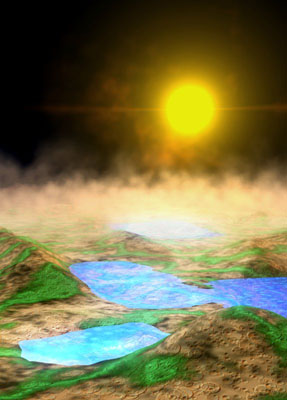Just a decade ago, scientists knew only nine planets - the ones that orbit the solar system. In 1995, improved detection techniques made it possible to discover the first solid evidence of a planet orbiting another star
Avi Blizovsky

Last month, three teams of astronomers announced the discovery of 12 new, previously unknown planets, bringing the number of known planets outside the solar system to 145.
Just a decade ago, scientists knew only nine planets - the ones that orbit the solar system. In 1995, improved detection techniques made it possible to discover the first solid evidence of a planet orbiting another star.
A proliferation of discoveries followed this discovery and now dozens of studies done around the world have steadily added to the number of worlds. Most of these planets are different from those in our solar system. They are more similar to Jupiter and Saturn than Earth, and most likely do not have life as we know it.
Last month's inventory count includes:
* Six gas giants discovered by two European teams of planet hunters. Two of these planets are very similar to Saturn, three belong to the "warm Jupiters" type due to their relative proximity to their Sun. The sixth is a gas giant with a mass 4.5 times that of Jupiter. All of these planets were discovered as part of the High Accuracy Radial velocity Planet Search (HARPS) project, an ongoing project centered at the La Silla Observatory in Chile.
• On January 20, a study was published in the online version of the Astrophysical Journal that described five gas giants by a team of American astronomers. The planets provide additional statistical data about the distribution and properties of solar systems, according to the study. The American team based its findings on observations made at the Keck Observatory in Hawaii, which is a joint project of the University of California and Caltech, and the observation time was granted to the researchers by both NASA and the University of California.
• Last week, Alex Wolzman Wolszczan of the University of Pennsylvania and Matsij Konacki of Caltech announced the discovery of the smallest planet outside our solar system, orbiting a pulsar – a neutron star. The size of the planet is about one-fifth that of Pluto. Three other planets already orbit that pulsar (PSR B1257+12.) Because the planets orbiting pulsars are constantly bombarded with strong radiation, they are considered unfit for life. For various reasons, the tables listing discovered planets do not count planets orbiting pulsars in their reservoirs but only planets orbiting normal stars.
Two detection methods
The planet orbiting the pulsar was discovered by watching the neutron star pulses - the timing of the pulsar. Changes in these pulses provide astronomers with the ability to calculate an accurate calculation that will help locate phenomena occurring in the pulsar's environment.
The gas giants were discovered using the radial velocity method, in which perturbations due to the presence of an invisible companion are detected in the back-and-forth motion of the system's main star. This motion can be detected as an alternating red and blue shift in the star's spectral lines.
If it means anything to anyone, these are the names of the new planets
* HD 2638 b
* HD 27894 b
* HD 63454 b
* HD 102117 b
* HD 93083 b
* HD 142022A b
* HD 45350 b
* HD 99492 b
* HD 117207 b
* HD 183263 b
* HD 188015 b
